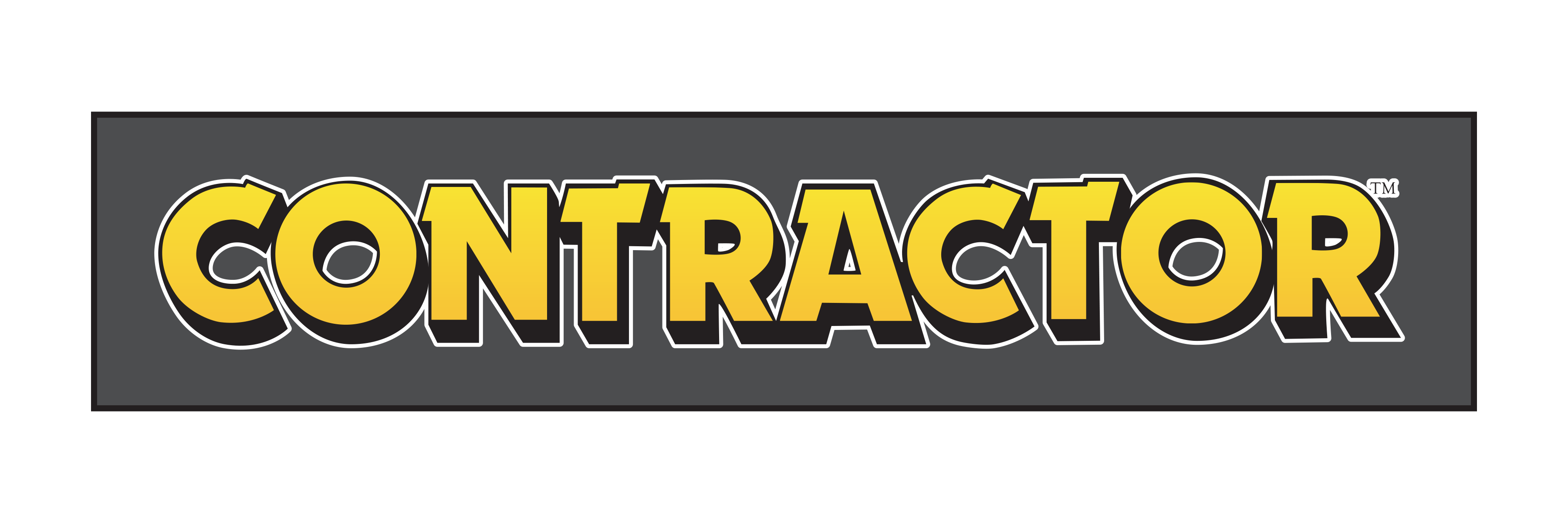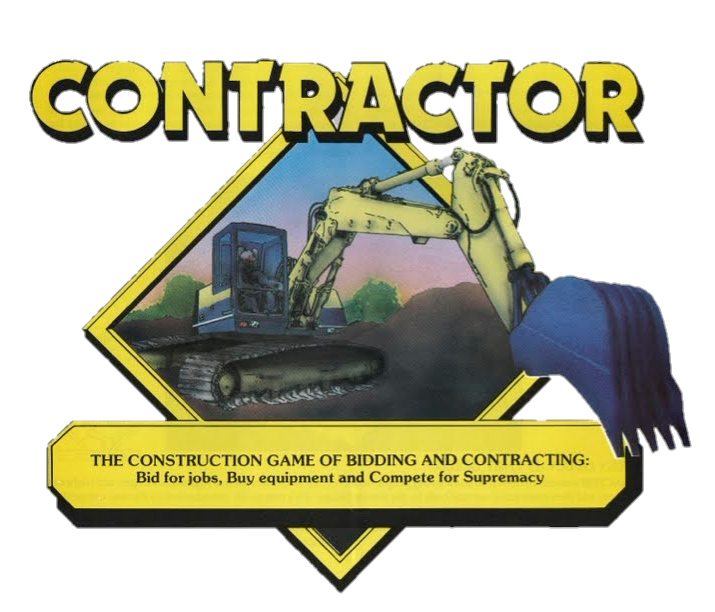

NOTE: You don't have to read all the rules. In the section on "Bidding", just read what pertains to the number of players present.
Here's your opportunity to become a "big time" Contractor! In this exciting game, each player assumes the role of a Contractor and tries to make the most money while constructing Dams, Bridges, Highrises, etc. The following steps parallel "real life" contracting:
NOTE: Machines, materials, and the Subcontractor are all referred to as equipment.
Stack equipment cards in any order and place in the center of the board. Players each shake both dice. (NOTE: at no point in the game do doubles result in an extra shake). Player who throws high dice takes the card from the top of the stack. Continue until the stack is gone. After bidding, players will buy some of their equipment and return them to the bank.
Players now bid on jobs. The cost of the job (as shown on the top of the Work Schedule) is the sum of all the rentals on that job. We recommend players bid higher than the cost of the job, but bids must be under $600,000. Bid prices must end in four zeros. (e.g. $480,000 or $500,000 are acceptable bids. $479,199 is not acceptable). Each job is awarded to the player who writes down the lowest bid price for that job. Tied low bids are resolved by shaking dice, with the job awarded to the player with low dice. Each time a job is awarded, write the low bid price and the low bidder's colour on the banker's second bid sheet.
| JOB | BID PRICE | LOW BIDDER’S COLOUR |
|---|---|---|
| DAM | $460,000 | YELLOW |
| HIGHWAY | $500,000 | BLUE |
| TUNNEL | $420,000 | WHITE |
| BRIDGE | $320,000 | GREEN |
| HIGHRISE | $450,000 | YELLOW |
| POWERLINE | $360,000 | GREEN |
When the Banker has recorded the low bids and the low bidder's colours, the bid sheet is placed on its designated spot on the board. The bid sheets that each player used can now be discarded. Players should place markers the same colour as their tokens, on the JOB PROGRESS SCHEDULE above the job(s) they have been awarded.
BIDDING STRATEGY: Try to get a job where the equipment you plan to buy is used in the first few phases and in the last few phases of the job.
Each player secretly writes down a bid for the Dam job. Then they expose their bids, and the Dam is awarded to the low bidder, and the Highway is awarded at cost to the other player. Then both players bid on the Tunnel. Bids are exposed, and the Tunnel is awarded to the low bidder, and the Bridge is awarded to the other player at cost. Each player will have two jobs. (With 2 players, only the first four jobs are regarded).
Each player secretly writes down bids for the first two jobs: Dam and Highway. Bids are exposed and the Dam is awarded to the low bidder. The Highway is then awarded to the low bidder, but not to the player who was awarded the Dam, even if his bid is lowest. Then the Tunnel is awarded at cost to the player who did not receive the Dam or the Highway. At this point each player will have one job. Then all three players write down bids for the Bridge and the Highrise. Bids are exposed, and the Bridge is awarded to the low bidder, but not to the player who was awarded the Bridge. Then the Powerline is awarded at cost to the player who was not low bidder on the Bridge or the Highrise. Each player will have two jobs.
Each player secretly writes down bids for the first three jobs: Dam, Highway, and Tunnel. Bids are exposed, and the Dam is awarded to the low bidder. Then the Highway is awarded to the low bidder, but not to the player who was awarded the Dam, even if his bid is lowest. Then the Tunnel is awarded to the low bidder, but not to either of the players who were awarded the Dam or the Highway. The fourth player who doesn't yet have a job is awarded the Bridge at cost. Each player will now have one job. Now all four players write down bids for the Highrise and the Powerline. Bids are exposed, and the low bidder is awarded the Highrise. Then the Powerline is awarded to the low bidder, but not to the player who was awarded the Highrise. Two players will have one job each and two players will have two jobs each.
Each player secretly writes down bids for the first four jobs, Dam, Highway, Tunnel, and Bridge. Bids are exposed, and the Dam is awarded to the low bidder. Then the Highway is awarded to the low bidder, but not to the player who was awarded the Dam, even if this bid is lowest. Then the Tunnel and next the Bridge are awarded to the low bidders, but not to any of the players who already have a job. Then the Highrise is awarded at cost to the fifth player who was not low bidder on any of the first four jobs. Then all five players bid on the Powerline, and it is awarded to the low bidder. Four players will have on job each and one player will have two jobs
Each player secretly writes down bids for the first five jobs; Dam, Highway, Tunnel, Bridge, and Highrise, Bids are exposed, and the Dam is awarded to the low bidder. Then the Highway is awarded to the low bidder, but not to the player who was awarded the Dam, even if his bid is lowest. Then the Tunnel, next the Bridge, and then the Highrise, are awarded to the low bidders, but not to any of the players who already have a job, Then the Powerline is awarded at cost to the sixth player, who was not low bidder on any of the previous jobs. Each player will have one job.
Players now buy the equipment they want, and return the rest of their equipment to the bank. To buy equipment, pay bank the price shown on the equipment card.
STRATEGIES: To earn immediate rental income, purchase equipment used at the beginning of the jobs. The Lowbed, Dozer, Subcontractor, Loader, Excavator, Trucks, Rockdrill and Scrapers are all good first choices to buy as they are used in the first two phases of the jobs.
When buying equipment, keep back enough cash (about $45,000) for operating expenses.
Place tokens on corner market START. The player who took the first equipment card shakes both dice and moves his token clockwise. After he has finished his play, the turn to play continues clockwise around the table. According to the space a player lands on, he may be entitled to work on his job(s), or he may be obliged to draw a Weather card, pay money for Mechanical Repairs, etc. Two or more tokens may be on the same space at the same time.
Always pick up a WORKDAY CARD when you land on a Workday space, even if you choose not to work that turn.
consists of completing a phase on your job. At each phase:
Equipment in the bank may be bought as follows: At anytime during your turn, you may choose and buy one piece of equipment from the bank. If you land on equipment that is in the bank, you pay no rent, and you may buy that piece of equipment for 10% less than full price.
At any time, equipment may be sold back to the bank for half price, or sold or traded with other players for a negotiated price. Money may be included in a trade.
When you land on a Weather Space, you must draw a Weather Card. Before reading the card, you must decide whether you will apply it to yourself or give it to another player, who must follow its instructions. Card is then returned to bottom of pile.
The Warranty Fund receives money each time players land on a space or draw a card that directs money to the fund. A player landing on the Warranty Fund space collects the money.
When you owe money, you must immediately pay the money before you work or buy equipment. If you do not have enough cash to pay what you owe, you must raise the money as follows:
Pay one-tenth of a player's bid price at the completion of each phase. For easier banking when a player has two jobs, add together both phase payments and write the figure on the bid sheet for reference. Then both jobs can be paid in one payment.
To complete your 10th phase, you must land on a Workday after rolling a 2, 3, 4, 5, or a 6 with your throw of the dice. If you roll a 7, 8, 9, 10, 11 or a 12 and land on a Workday space after you have completed your ninth phase, you do not draw a Workday card and you may not work on your tenth phase. The first player to complete all ten phases on all his jobs receives a $50,000 bonus from the bank. Play then stops and the other players pay to the bank, all the equipment costs on the uncompleted phases of their jobs, except for the equipment they own. They receive no payment for uncompleted phases. All players then sell their equipment back to the bank for half price, loans are repaid at $100,000 for each loan and money is added up.
The CONTRACTOR who made the most money wins.
THE WORK SCHEDULE EARNINGS CHART on the board shows the total of the work schedule rentals for each piece of equipment. It can be used as a value guide when buying, selling, and trading equipment.
PLAYERS SHOULD ROLL DICE on their Work Schedules so markers on the board are not disturbed.
© COPYRIGHT 2022 BY CONTRACTORGAME.COM
